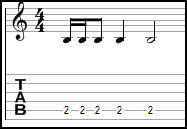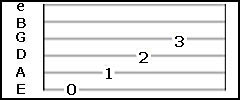Not everyone has the time or patience to learn how to read and write music with standard notation. Tablature, also called tabulature or tabs, is the world-renown solution that proves to be much faster in terms of learning, writing, or reading a song in standard notation. In fact, it is much more likely that a guitarist seeking to learn a song will find tablature long before standard notation is found.

Figure 1 – The top shows standard notation, while the bottom shows tablature. Notice how there is no rhythm or timing for tablature, as compared to standard notation.
Tablature works on the simple principle of telling guitar players where to place fingers, and can even signal special effects sch as a vibrato or hammer-on. The guitar community usually shortens the word tablature to tab, to save time and effort. To start out, Figure 2 shows a standard tablature measure:

There are six lines in this example- one for every string on the standard guitar. You may have noticed the e, B, G, D, A, and E next to each line. This labels which string the tablature is referencing on the guitar. The top, or string “e”, will always be the smallest string on the guitar. The bottom, or string “E”, will always be the thickest string on the guitar. The rest of the letters represent the strings in between. To avoid confusion, the “e” string is called &lquo;little e”, and the “E” string is called “big E.”
The numbers on figure 2 represent where the finger should be placed on the fretboard. Notice how string E has the number 0 on it. This means that you play the string “open”, which means just pluck the string without holding any frets down. The next number is a 1, and it is on the A string. This means that the second string should be held down at fret 1, which is at the top of the guitar neck. It is fairly simple, as you have found out, to play music this way.
While playing this example of “Mary had a Little Lamb”, take it slow. Learning tablature is simple, but may take some growing accustomed to. Also try and see if you can figure out any flaws in the tablature system while playing:
Mary had a Little Lamb


While playing the example, it is more than likely that you noticed there are some timing and rhythm problems with tablature. Tablature has no way of telling the player when to play a note, and can only poorly, if at all, indicate a musical “rest.” This is certainly no problem for “Mary had a Little Lamb” tab, but compositions in genres such as classical music are impossible to play in tablature. Most songs will be completely fine, as the song is usually already heard before trying to play it.
Every example so far has used single nots- something most songs do not abide by. Instead, chords are used to give a healthier sound to the music. A chord is simply two or more notes sounded together at the same time. Look at the below example of the same song above, only played with chords. (As a hint, try playing the third note with the index and pinky finger. The “0”, or open string, means to strum the string without holding a fret down.)
Mary had a Little Lamb Verse 1 (With chords) :

The song now sounds much more “full”, and gives a healthier sound. For more advanced techniques, special characters are used to inicate a hammer-ons, pull-offs, and much more. Often, different tabs will have different letters or symbols indicating a special technique.
A slide usually uses the format of “fret number / fret number” or “fret number s fretnumber”, which would look like a “4/6” and “4s6” using the fourth and sixth fret. The “/” usually indicates an ascending slide, while the “\” indicates a descending slide.

A hammer-on or pull-off usually takes the form of “fret number H fret number”, which would look like a “4h6” in a real world example (“4p6” for a pull-off). Hammer-ons are simply pressing down a string at the given fret number without plucking. This won’t make a big difference in sound, as nothing is plucked, but it will provide a feint sound. A Pull-off is more common, and is accomplished by pressing down on the fret number given, and then quickly releasing. It gives a nice reverberating sound after the note, and is usually more common than a hammer-on.
A vibrato is simply “wiggling” a string up and down (usually fast), to give an interesting change in pitch for the note. This is usually done by the “v” letter or the “~”. (9~, 9v)
A string mute, also known as a rake, gives a harmonic and percussive sound to guitars. It is simple to do- hold down a string with the right palm, where you would pluck it. Now pick the string- and notice the change in sound. Muting can also be down with the left hand- both ways give different sounds. This is almost always shown as an “X” or “x”.

With these basics learned, reading tablature is the first step to learning new and exciting material. By all means, learn something with a little more excitement than “Mary had a Little Lamb”- there is a wide range of music to choose from. Keep in mind that learning a new song usually requires correct timing information- and this is where tablature books come in. Tablature books, also known as sheet music, will give standard notation and tablature- so timing and rhythm aren’t a problem (a little music theory will be necessary most likely). Programs, such as GuitarPro, will also let users read, write, and play tablature with incredible ease. It isn’t free- but it has an amazing amount of tabs written for it, and the ability to play what the tabs should sound like is invaluable. Finding tablature may be hard, as it has recently become an issue with legal concerns- but a little searching will no doubt get you started on the pathway to a long and exciting hobby orcareer with guitar playing.